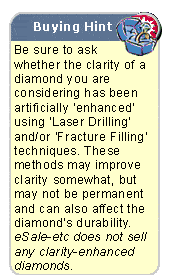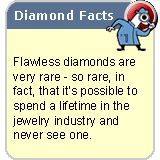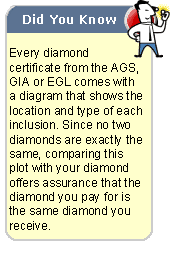



|
Definition: A diamond's clarity refers to its relative freedom from imperfections - internal inclusions and/or surface blemishes. Flawless diamonds are absolutely clear; they are the most sought after and consequently, the most expensive. However, few things in nature are absolutely perfect, and diamonds are no exception. Most diamonds have internal features, called inclusions, and surface irregularities, called blemishes. Together, they are the diamond's 'clarity characteristics'. Clarity is the relative absence of these clarity characteristics. Blemishes are surface imperfections including scratches and nicks. Inclusions are internal, though some might break the surface. Tiny diamond or other mineral crystals may be trapped within the diamond as it forms. Depending on their size and location, they may still be there after the diamond has been cut and polished. For more detailed information on inclusions and blemishes. |
 |
|
How
is clarity graded?
|
|
Clarity
and Value For
example, let's compare the approximate value of 1.0 ct., F-color,
'Ideal'-cut round diamonds at different clarity grades:
|
||||||||||||||||||||||||||||||
